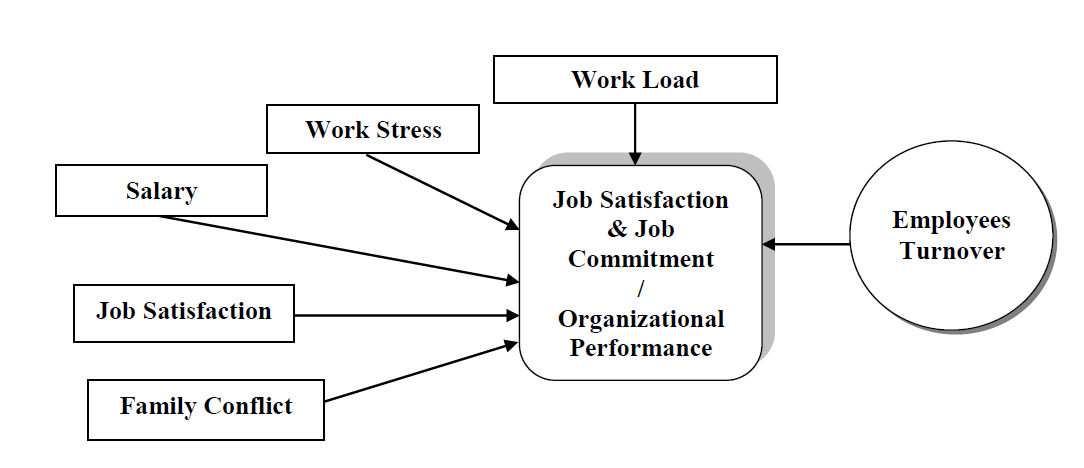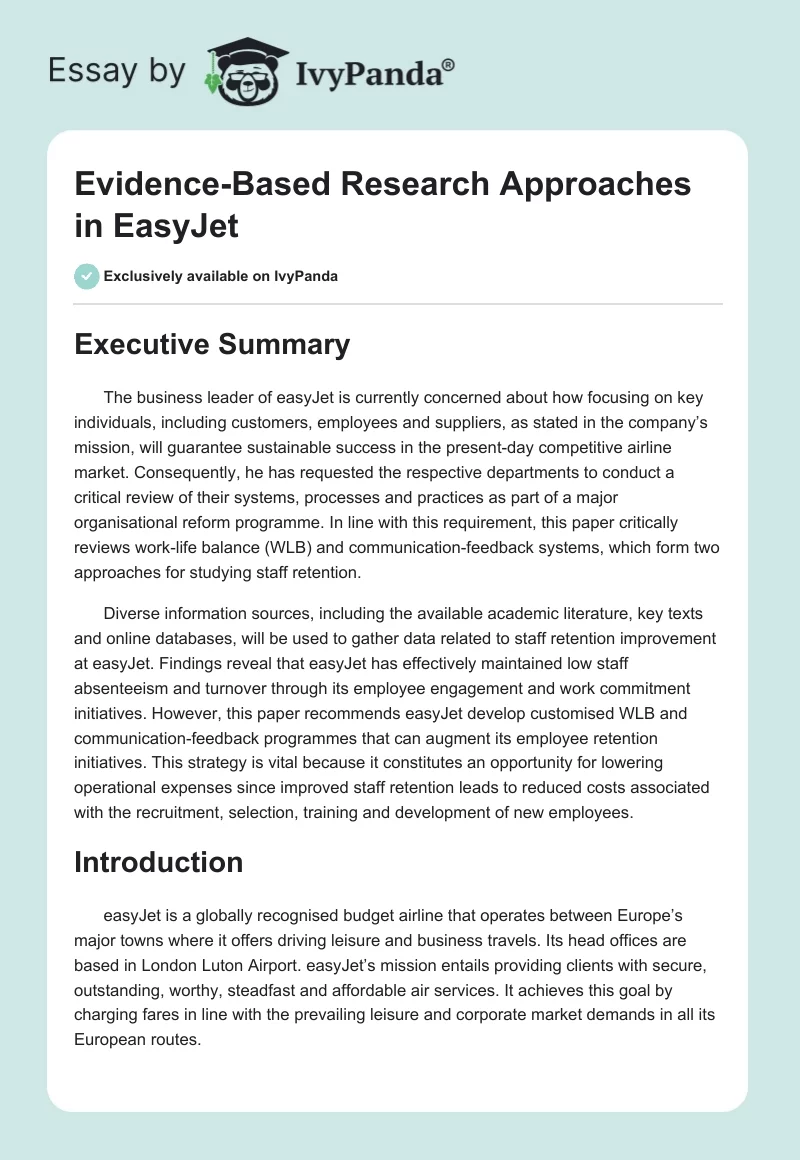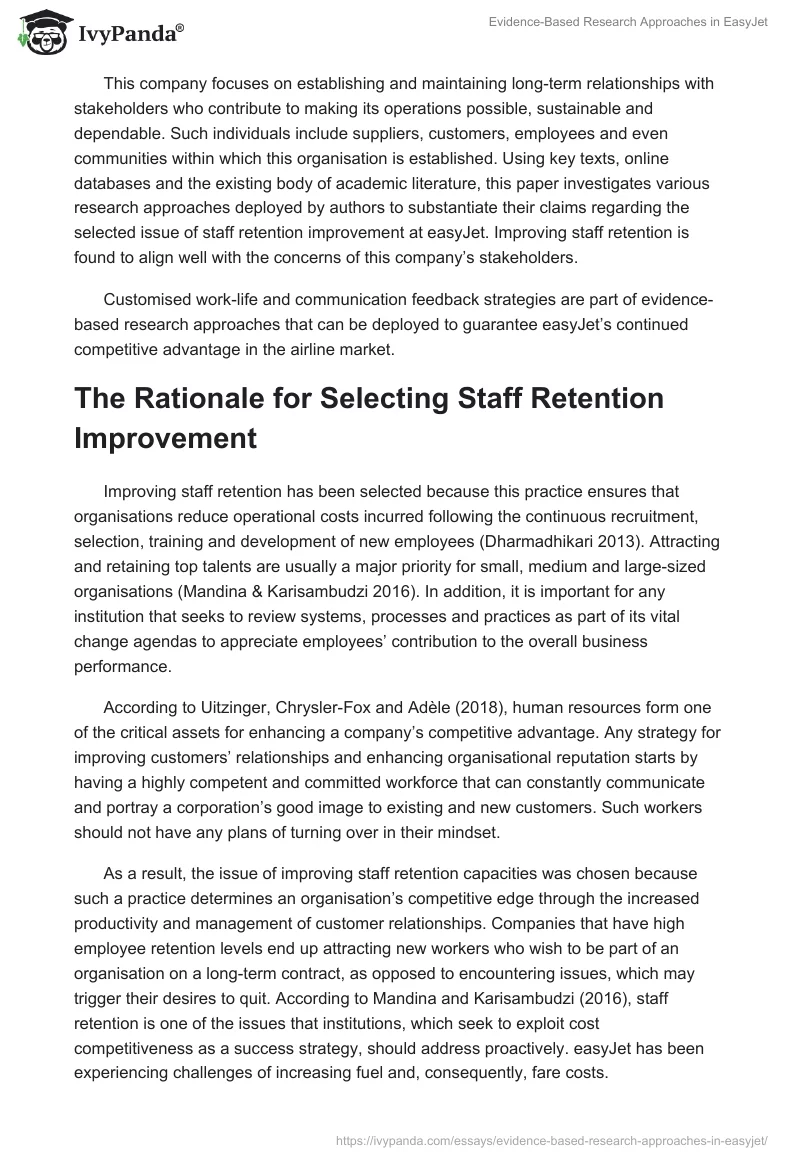Executive Summary
The business leader of easyJet is currently concerned about how focusing on key individuals, including customers, employees and suppliers, as stated in the company’s mission, will guarantee sustainable success in the present-day competitive airline market. Consequently, he has requested the respective departments to conduct a critical review of their systems, processes and practices as part of a major organisational reform programme. In line with this requirement, this paper critically reviews work-life balance (WLB) and communication-feedback systems, which form two approaches for studying staff retention.
Diverse information sources, including the available academic literature, key texts and online databases, will be used to gather data related to staff retention improvement at easyJet. Findings reveal that easyJet has effectively maintained low staff absenteeism and turnover through its employee engagement and work commitment initiatives. However, this paper recommends easyJet develop customised WLB and communication-feedback programmes that can augment its employee retention initiatives. This strategy is vital because it constitutes an opportunity for lowering operational expenses since improved staff retention leads to reduced costs associated with the recruitment, selection, training and development of new employees.
Introduction
easyJet is a globally recognised budget airline that operates between Europe’s major towns where it offers driving leisure and business travels. Its head offices are based in London Luton Airport. easyJet’s mission entails providing clients with secure, outstanding, worthy, steadfast and affordable air services. It achieves this goal by charging fares in line with the prevailing leisure and corporate market demands in all its European routes.
This company focuses on establishing and maintaining long-term relationships with stakeholders who contribute to making its operations possible, sustainable and dependable. Such individuals include suppliers, customers, employees and even communities within which this organisation is established. Using key texts, online databases and the existing body of academic literature, this paper investigates various research approaches deployed by authors to substantiate their claims regarding the selected issue of staff retention improvement at easyJet. Improving staff retention is found to align well with the concerns of this company’s stakeholders.
Customised work-life and communication feedback strategies are part of evidence-based research approaches that can be deployed to guarantee easyJet’s continued competitive advantage in the airline market.
The Rationale for Selecting Staff Retention Improvement
Improving staff retention has been selected because this practice ensures that organisations reduce operational costs incurred following the continuous recruitment, selection, training and development of new employees (Dharmadhikari 2013). Attracting and retaining top talents are usually a major priority for small, medium and large-sized organisations (Mandina & Karisambudzi 2016). In addition, it is important for any institution that seeks to review systems, processes and practices as part of its vital change agendas to appreciate employees’ contribution to the overall business performance.
According to Uitzinger, Chrysler-Fox and Adèle (2018), human resources form one of the critical assets for enhancing a company’s competitive advantage. Any strategy for improving customers’ relationships and enhancing organisational reputation starts by having a highly competent and committed workforce that can constantly communicate and portray a corporation’s good image to existing and new customers. Such workers should not have any plans of turning over in their mindset.
As a result, the issue of improving staff retention capacities was chosen because such a practice determines an organisation’s competitive edge through the increased productivity and management of customer relationships. Companies that have high employee retention levels end up attracting new workers who wish to be part of an organisation on a long-term contract, as opposed to encountering issues, which may trigger their desires to quit. According to Mandina and Karisambudzi (2016), staff retention is one of the issues that institutions, which seek to exploit cost competitiveness as a success strategy, should address proactively. easyJet has been experiencing challenges of increasing fuel and, consequently, fare costs.
For example, fluctuations in energy prices prompted it to implement the project technology, which saved it about 14 million Euros (easyJet plc 2017). Organisations such as easyJet, which need to benefit continuously from innovative technologies to reduce operations costs, cannot overlook the idea of improving their staff retention practices. As a result, easyJet will always be guaranteed the input of experienced employees who have a high probability of getting opportunities in other companies.
Literature Review
Staff Retention and the Underlying Factors
Several articles were taken from online databases such as EBSCOhost to support claims regarding the issue of staff retention. Mwasaru and Kazungu (2015) define staff retention as the ability to maintain a working environment that supports the demands of current employees to allow them to work without decreasing their productivity levels. The implication is that workers can consider leaving an organisation depending on different factors that may influence their decision-making processes. As shown in Figure 1 below, Mathimaran and Kumar (2017) identify some of these factors.

In the airline industry, retention may be influenced by elements such as huge workloads, poor work-life balance (WLB), unfavourable recognition and reward systems and inefficient communication and feedback systems (Sirgy & Lee 2018; Soundarapandiyan & Ganesh 2015; Carlson 2015). Nevertheless, after adopting literature review as their preferred research approach, factors identified by Sirgy and Lee (2018) constitute important concerns in any human resource department, irrespective of an organisation’s industry of operation. This research strategy allows authors to assess varied views regarding a single element.
However, it may lead to biased conclusions based on the number of studies consulted. According to Nizam and Kam (2018), companies establish human resource management departments to facilitate the recruitment of the most productive workers, remunerate them accordingly and resolve employee-employer and employer-employee conflicts. These efforts involve ensuring the existence of customised work-life balance structures and communication and feedback systems.
Staff Retention at easyJet
Key texts regarding the company under investigation, including data from its website, will be used to examine the issue of staff retention. easyJet bases its organisational culture on the issue of promoting employees’ continuous performance and engagement. Consequently, it can use them to achieve its goal of providing optimal customer services as a primary means of building long-term relationships. The article, easyJet plc (2017), which was accessed from key texts appropriate for this subject, relies on the company’s reports as its research approach. This strategy is advantageous because scholars have the opportunity of accessing first-hand data. However, company-related information may be misstated to satisfy the interests of specific stakeholders.
In the effort to remain positive and friendly to employees, easyJet’s managerial strategies aimed at ensuring effective chains of consistent and continuous communication regarding key issues that touch on employees (easyJet plc 2017). This situation explains its low rate of absenteeism. For example, in 2012, work attendance stood at 95 percent before improving to 96 percent in 2013 (easyJet plc 2017).
This company has maintained low employee turnover levels due to its effective human resource management practices. For example, in 2012, turnover stood at 7.5%, which reduced to 6.5% in 2013 (easyJet plc 2017). However, as argued in the section on staff retention and its influencing factors, the available literature from earlier mentioned information sources indicates other approaches that can be deployed to improve easyJet plc’s staff retention levels.
Work-Life Balance
A growing body of literature investigates strategies for improving retention capacities among workers. For example, Gözükara and Çolakoğlu (2016) use a qualitative research approach to identify communication, motivation, delegation and safe working environments as important factors that influence employee retention levels. Amid the importance of these aspects, Nizam and Kam (2018) argue that work-life balance strategies are rarely addressed when examining the issue of improving employee retention levels.
Hence, the adoption of customised work-life initiatives as a way of retaining employees provides an additional perspective on how easyJet can augment its performance, thanks to the existence of experienced personnel. According to Gözükara and Çolakoğlu (2016), supervisors in some organisations are not aware of the crucial role they can play in boosting organisational productivity. Consequently, their improved commitment and reduced work absenteeism levels are valuable.
Quoting research published in 2009, Dizaho, Salleh and Abdullah (2017) argue that 69% of the total absenteeism in organisations occurs when employees skip work to attend to their personal needs other than sickness. This observation raises an important scholarly question regarding the need for investigating the primary causes of absenteeism, despite being low at 4% in 2013 at easyJet. Studying staff retention improvement from the WLB perspective using the qualitative data approach is advantageous.
It paves the way for organisations to offer room for employees to take care of their personal needs. Yue, Domagalski and Zanglein (2017) support this approach by noting that absenteeism correlates negatively with organisational productivity. Absenteeism is important in establishing the link between work-life balance and retention because it encompasses a short-term form of employees’ retention problems.
In the effort to lower work-life balance conflicts, organisations introduce policies for improving employees’ working experiences by balancing their personal lives and job demands (Dominus 2016). Such guidelines allow them to enjoy memorable experiences outside the work environment by engaging in other constructive programmes. These activities include increasing workers’ educational skills, participating in social events and leisure, among others (Bansal & Agarwal 2017; Prakash 2018).
According to Pandita and Singhal (2017), employees may leave their jobs to address personal matters, for instance, maternity demands, seeking opportunities for upward career progression and taking breaks from monotonous works. Hence, where an organisation does not provide room for workers to attend to these issues, they are likely to consider quitting. Guided by these concerns, easyJet can implement flexible job policies such as allowing teleworking, video-conferencing, offering part-time jobs and reducing working hours (Jowit 2016). However, work-life balance approaches for retaining employees may be disadvantageous due to scholarly disagreements regarding the definition of non-work aspects that help to lower turnover and absenteeism.
Communication and Feedback
Maintaining a highly committed workforce does not only concern HR departments but also CEOs, especially those who are keen to acquire profitable business lines (Bari, Fanchen & Baloch 2016). Hence, business leaders need to devise appropriate strategies for ensuring effective communication, which, in turn, boosts staff retention levels (Gutierez 2014). Bhardwaj, Sharma and Deepshikha (2017) and Cox (2014) advise such CEOs to listen to employees’ concerns and provide the appropriate feedback that captures the desire to implement suggestions raised.
This strategy helps workers to feel valued and hence their minimal turnover plans. This counsel complies with approaches deployed by easyJet in its communication approaches. Figure 2 shows different ways in which an organisation can classify its communication approaches. easyJet ensures both vertical and horizontal communication as the strategy for providing a positive and friendly working environment.

Bari, Fanchen and Baloch (2016) investigated communication and retention in terms of outcomes such as organising regular meetings with staff, offering consistent reviews of their performance, encouraging commitment to professional development and learning and engaging in periodic interviews. This approach to analysing the role of communication in enhancing staff retention is advantageous since it reveals important critical concerns that lead to turnover intentions identified by Mathimaran and Kumar (2017).
However, Bari, Fanchen and Baloch’s (2016) approach is disadvantageous since it does not provide a toolkit on how different industries can apply customised communication strategies to retain their employees. Moreover, it does not clarify whether variations are observable based on the outcomes of the stated four approaches when applied to different organisations. Despite this challenge, Murray and Fluker (2017) and Robins (2018) present communication as an important aspect of enhancing staff retention and, consequently, organisational success.
Conclusion and Recommendations
Mentorship programmes, employee compensations, recognition and reward systems, work-life balance, training and development, communication and feedback and supporting teamwork constitute some of the important approaches to studying staff retention. easyJet’s values, as stated in its mission, underline the importance of communication and reward systems in enhancing employee retention levels. The outcome of these strategies is evident in the low turnover and absenteeism recorded in this company.
To support this achievement, this company should explore additional approaches to staff retention, such as implementing work-life balance and communication feedback mechanisms that are tailor-made to satisfy employees’ unique needs. This recommendation not only supports easyJet’s idea of employee retention improvement but also has additional advantages, including reducing absenteeism, increasing work commitment, minimising turnover intentions and boosting the capacity to recruit and maintain an outstanding pool of workers.
Reference List
Bansal, N & Agarwal, UA 2017, ‘Exploring work-life balance among Indian dual working parents: a qualitative study’, Journal of Management Research, vol. 17, no. 2, pp. 99-111.
Bari, MW, Fanchen, M & Baloch, MA 2016, ‘Management practices and performance of mergers and acquisitions in Pakistan: mediating role of psychological contract’, Springer Plus, vol. 5, no. 1, pp. 1-16.
Bhardwaj, S, Sharma, V & Deepshikha, B 2017, ‘A study on managerial communication in multicultural workplace’, Journal of Management Research, vol. 9, no.1, pp. 60-65.
Carlson, JS 2015, ‘Factors influencing retention among part-time clinical nursing faculty’, Nursing Education, vol. 36, no.1, pp. 42-45.
Cox, A 2014, ‘Increasing purposeful communication in workplace: two school-district models’, Delta Kappa Gamma Bulletin, vol. 80, no. 3, pp. 34-38.
Dharmadhikari, S 2013, ‘Cost optimisation through internal talent retention strategies: an analytical study’, CLEAR International Journal of Research in Commerce & Management, vol. 4, no. 12, pp. 37-41.
Dizaho, EK, Salleh, R & Abdullah, A 2017, ‘Achieving work life balance through flexible work schedules and arrangements’, Global Business and Management Research, vol. 9, no. 1, pp. 455-465.
Dominus, S 2016, ‘Rethinking the work-life equation’, The New York Times. Web.
easyJet plc 2017, Corporate responsibility. Web.
Gözükara, İ & Çolakoğlu, N 2016, ‘Mediating effect of work family conflict on the relationship between job autonomy and job satisfaction’, Social and Behavioural Sciences, vol. 22, no. 9, pp. 253-266.
Gutierez, A 2014, Effective communication in the workplace: learn how to communicate effectively, CreateSpace Independent Publishing Platform, Scotts Valley, CA.
Jowit, J 2016, ‘Work-life balance: flexible working can make you ill, experts say’, The Guardian. Web.
Mandina, SP & Karisambudzi, J 2016, ‘Customer retention strategies: a panacea to reducing attrition in Zimbabwean airline’, Journal of Marketing Development & Competitiveness, vol. 10, no. 2, pp. 91-110.
Mathimaran, B & Kumar, A 2017, ‘Employee retention strategies-an empirical research’, Global Journal of Management and Business Research: E-Marketing, vol. 17, no. 1, pp. 16-22.
Murray, MC & Fluker, J 2017, ‘Transforming communications in the workplace: the impact of UC on perceived productivity in a multi-national corporation’, Interdisciplinary Journal of Information, Knowledge and Management, vol. 12, pp. 175-187.
Mwasaru, H & Kazungu, KW 2015, ‘Effects of employee retention on organisational competitiveness advantages in the hotel industry in Mombasa County’, CLEAR International Journal of Research in Commerce & Management, vol. 6, no. 3, pp. 1-4.
Nizam, I & Kam, C 2018, ‘The determinants of work-life balance in the event industry of Malaysia’, International Journal of Management, Accounting, & Economics, vol. 5, no. 3, pp. 141-168.
Pandita, S & Singhal, R 2017, ‘The influence of employees engagement on the work-life balance of employees in the IT sector’, IUP Journal of Organisational Behaviour, vol. 16, no. 1, pp. 38-57.
Prakash, V 2018, ‘Work-life balance: perceptions of the non-work domain’, Sage Journal, vol. 2, no. 1, pp. 1-11.
Robins, A 2018, 13 ways to improve communication at work, weblog. Web.
Sirgy, MJ & Lee, D 2018, ‘Work life balance: an integrative review’, Applied Research in Quality of Life, vol. 13, no. 1, pp. 229-254.
Soundarapandiyan, K & Ganesh, M 2015, ‘Employment retention strategy with reference to Chennai based ITES industry–an empirical study’, Global Management Review, vol. 9, no. 2, pp. 1-13.
Uitzinger, D, Chrysler-Fox, P & Adèle, T 2018, ‘Perceptions of human resource professional of challenges to and strategies for retaining managers’, Acta Commercii, vol. 18, no. 1, pp. 1-10.
Yue, H, Domagalski, T & Zanglein, J 2017, ‘A qualimetric approach to work-life balance’, Tamara Journal for Critical Organisation Inquiry, vol. 15 no. 3/4, pp. 237-348.


